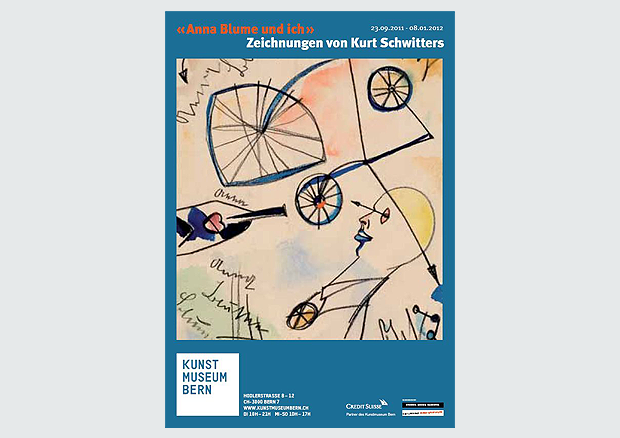«Anna Blume and I». Drawings by Kurt Schwitters, 23.09. 2011 - 08.01.2012
Drawing as a Field for Experiment
Kurt Schwitters (1887–1948) is one of the leading protagonists of 20th-century art. He revolutionized the collage with his so-called Merz pictures, which he assembled from newspaper cutouts, advertisements, fabric, metal, and even rubbish. And furthermore, today we see in him a pioneer of contemporary installation art. The exhibition in the Kunstmuseum, however, testifies to another side of the artist – to the fact that Schwitters was also a highly innovative draftsman.
Kurt Schwitters’ renown as an artist who produced collages and installations out of very diverse materials is widespread. In the case of Ausgerenkte Kräfte (Dislocated Forces, 1920), the Kunstmuseum Bern can boast a key work of Schwitters’ Merz art in its collection. The former director Max Huggler, in circumstances of great hardship, purchased the work in 1961 with his own savings – and donated the artwork to the Kunstmuseum Bern after its treasurer had thwarted the museum’s attempts to purchase it. Today the picture is one of the highlights in our collection.
A surprising diversity
The exhibition offers the first overview of Kurt Schwitters’ graphic work
with around 100 selected drawings from the artist’s estate as well as
from private collections. His drawings received very little attention in the past because they, at least on the surface, appeared to have little in common with his Merz art.
Schwitters' drawing oeuvre can be divided into various styles: They
range from dada and constructivism to realism, and can even display
surrealist overtones. This great diversity illustrates decisive turning
points in the artist’s career and in his stylistic development. It
lucidly demonstrates Schwitters' path to abstraction around 1918 as well as his experiments with a constructivist language of forms.
In 1937 Schwitters visited Norway and did not to return to Germany. The
Nazis classified him as a degenerate artist, and his work was
confiscated and slandered. He was forced to flee to Scotland when German troops marched into Norway in 1940. He was interned there as a
foreigner in different camps. Schwitters was able to establish a studio
in Hutchison Camp on the Isle of Man, where he portrayed his fellow
internees. Still today these portraits represent the culmination of his
art in portraiture.
Schwitters’ familiarity and affinity to nature is especially discernible in his drawings. Impressed by the mountain scenery in Norway and
England he started drawing landscapes. Many of these are hurriedly
sketched, almost abstract works, but also a number of realistic
representations have survived.
The exhibition shows that Schwitters did not just choose to draw as a
finger exercise but, in this art, found an important source of
inspiration and a field for experiment his whole life long. As a way for exploring nature and versatile medium, through drawing he developed his own characteristic language of visual forms.
The inspiring Anna Blume
Again and again, Schwitters combined the traditional genres of painting, drawing, printmaking, poetry, and script. The exhibition title “Anna
Blume and I” not only refers to Schwitters’ dadaistic love poem
dedicated to his fantasy beloved, but also to a water color in the show
with the same name. Schwitters’ Anna Blume likewise inspired the hip-hop group Freundeskreis to compose their song “A.N.N.A.” – and additionally appears as a literary figure in several works by the American author
Paul Auster.
The exhibition is a
collaborative effort with the Sprengel Museum Hannover and the Kurt and
Ernst Schwitters Foundation, which, based in Hanover, administers Kurt
Schwitters' legacy.


